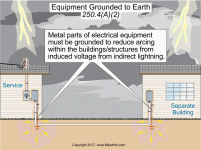goldstar
Senior Member
- Location
- New Jersey
- Occupation
- Electrical Contractor
I apologize for bringing this topic up again, I know it's been beat to death. I'm interested in the logic behind the Code section. I researched and found this older thread :
So, as I understand it, if you run a single 20 (or 30) amp, 120V circuit to a detached garage you don't need a supplemental ground rod to re-establish the ground. You can also use one snap switch as a disconnect means. However, if you terminate that single circuit in a 4-circuit main lug breaker panel, that single circuit becomes a feeder and now you'll have to install a ground rod.
If someone can explain the logic behind that I would appreciate it
detached garage one circuit; grd rod, disconnect required ?
For a residential detached garage with only one branch circuit (20 amp, single pole), is a ground rod or disconnect required ? Thank you.
forums.mikeholt.com
So, as I understand it, if you run a single 20 (or 30) amp, 120V circuit to a detached garage you don't need a supplemental ground rod to re-establish the ground. You can also use one snap switch as a disconnect means. However, if you terminate that single circuit in a 4-circuit main lug breaker panel, that single circuit becomes a feeder and now you'll have to install a ground rod.
If someone can explain the logic behind that I would appreciate it


